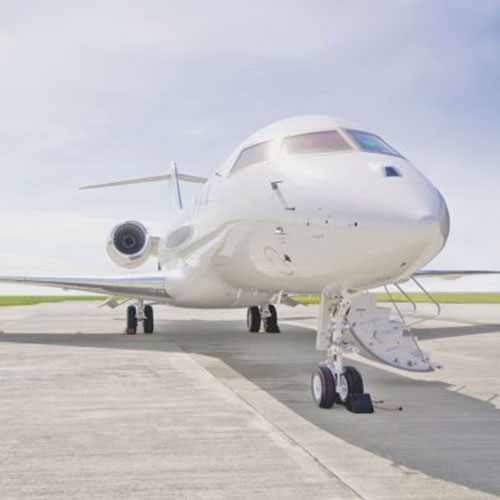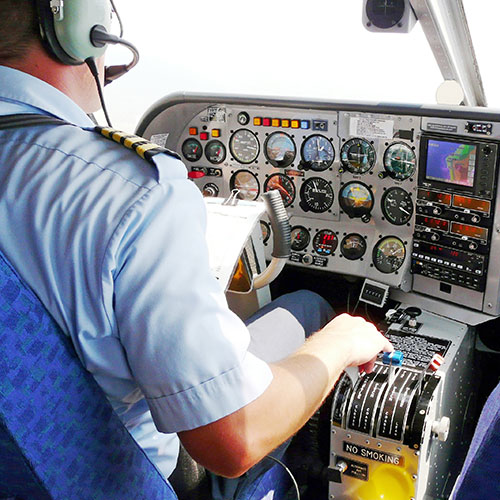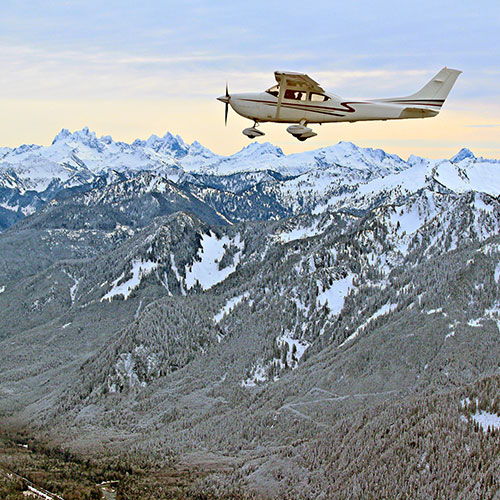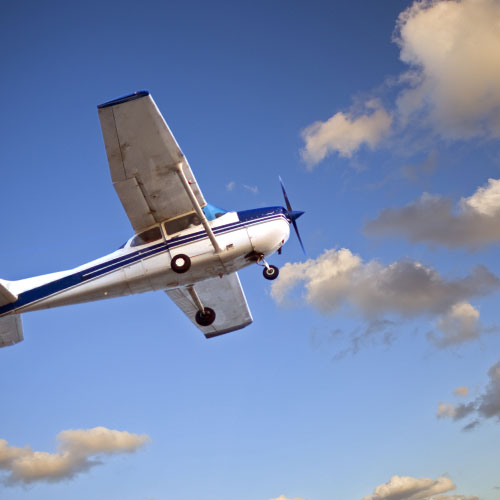FEATURED NEWS - * COVER STORIES *
Small Airports
Small Airports
Hidden Gateways to the Clouds
Written By Ryan Lessard (news@hippopress.com)
Images: Stock Photo
Many towns and cities in New Hampshire have airports that you probably didn’t know existed. Primarily, they offer a travel destination to recreational flyers and business commuters, a place to keep their planes, repair and refuel.
While Dave Rolla, the airport manager at Concord Municipal Airport, can’t speak for every airport in the state, he says it’s likely that many of those small fields also offer flight training services.
“It’s certainly pretty common that where there are airplanes there are people who are willing to teach people how to fly,” Rolla said.
General Aviation
These so-called general aviation airports are more common in New Hampshire than most realize. There are 25 airports in the state, 15 public and 10 private.
“The biggest thing to understand is, geographically speaking, it’s amazing that New Hampshire has that many airports that can accommodate aircraft,” Rolla said.
Only three of them (Manchester, Portsmouth and Lebanon) are classified “Part 139” airports, meaning they offer air carrier or passenger service.
Manchester and Lebanon are also bigger, with 10,000-foot runways.
That classification means they have TSA security and baggage security. Rolla said that after the attacks on Sept. 11, 2001, federal security rules for airports effectively made it impossible for smaller airports to grow to the level of a Part 139 because of the prohibitive costs associated with the security requirements.
So the remaining airports, like the ones in Concord, Nashua, Laconia, Keene and Jaffrey, rely heavily on recreational and business flights.
Plane Types
Rolla said his company, Concord Aviation Services, is the main operator of the airport, which is owned by the city, and one of five organizations that lease space there. There’s also the New Hampshire Army

National Guard, New Hampshire State Police and two private hangar operators.The Guard makes up most of the money paid to the city for its use of the airport, from hangar leases, fuel and outside parking. But of the estimated 10,000 customers Concord Aviation Services deals with regularly, Rolla said the vast majority are recreational vehicles.
“By sheer number of operations, I would say the bulk of New Hampshire airports are being visited by recreational pilots in small airplanes,” Rolla said.
He estimates 90 percent of the planes are small planes like Cessnas, single or twin engines with fewer than 12 seats.
According to the state Aeronautics Bureau, the state had 1,026 licensed aircraft in calendar year 2016.
Many use the airport for long-term parking. Rolla said Concord Aviation Services charges $45 a month for a small plane to stay at the airport. They also rent out planes.
The remaining 10 percent are mid-sized private jets for commercial use. Business people can make more efficient use of their time by flying between company locations or business meetings than driving there.
A common jet is the Bombardier Global Express 6000, and Rolla said he sees them in Concord regularly.
“If they’re a company that’s working internationally, that’s a common aircraft that they use,” Rolla said.
They can operate easily on 6,000 feet of runway and are able to fly internationally with a range of 6,000 nautical miles. But even though they are the less common plane, they spend more at the airport.
“In terms of dollars, it’s split the other way around. Because that Global Express that comes in, those guys can say, ‘Can you roll up that fuel truck and empty it into our plane?’ And it’s a 3,000-gallon fuel truck,” Rolla said.
To put that in perspective, a small plane can fly for an hour and burn 10 gallons.
Small airports like Concord’s can sometimes even accommodate larger carriers in a pinch, though it’s not practical. Rolla said the Secret Service once examined the airport and determined that a Boeing 757 could land there if it needed to.
Traffic Control
The Nashua airport at Boire Field is one of the few small airports with its own control tower, kept running partly with federal dollars.
But small, general aviation airports generally operate just fine without having a ground tower on site.
Rolla said on clear days when it’s uncontrolled airspace, pilots don’t need to file a flight plan with the FAA. They tap into a shared radio station that is local to the airport they’re landing at or taking off from called a Common Traffic Advisory Frequency and everyone just announces what they’re doing on the channel.
In this sense, it’s fairly self-regulated. Rolla said Concord is a “Class E” airspace, which means it’s generally less densely populated with aircraft, so there’s less need for a central traffic controller.
On days when visibility is low, pilots are under instrument flight rules, and they have to file flight plans and keep in contact with FAA traffic controllers.
Pretty much all of northern New England airspace is managed by the Boston Consolidated TRACON station in Merrimack.
If you’re taking off from an airport that has a tower then you communicate with them until take-off, at which point you’re handed off to the FAA controllers at the TRACON station.
Learning to Fly
Learning to Fly
Flight Lessons & Pilot's Licenses Let You Fly on Your Own
Written By Kelly Sennott (ksennott@hippopress.com)
Images: Stock Photo
If you’ve ever dreamed about flying a plane, it may be more attainable than you think.
Here’s a rundown of what it takes to get in the air on your own.
Pilot’s Licenses
There are two main types of pilot’s licenses: private and commercial. A private license allows you to fly yourself and your passengers recreationally.
“That’s the most popular license,” said Michael Johnson, flight instructor for Concord Aviation Services. “That’s what people get if it was always a dream of theirs to fly a plane and be a pilot and they want to get into it as a hobby.”
To earn a private pilot’s license, you must complete a minimum of 40 hours of flying time, which must consist of at least 20 hours flying with an instructor and 10 hours of supervised solo flying.

A commercial pilot’s license allows you to fly for hire. Transporting people or cargo, aerial photography, scenic flights and flight lessons are a few of the services you could offer as a commercial pilot. This license requires 250 hours of flying time, also consisting of at least 20 hours with an instructor and 10 hours solo.
In addition to the flying hours, a prospective pilot must pass a test that includes a multiple choice written knowledge test, an oral interview and a practical flying test with an examiner.
“The pilot examiner will ask you questions and try to figure out what you know,” Johnson said. “Then, he’ll run you through various maneuvers like take-offs and landings and turns so you can demonstrate that you know how to fly.”
Flight Lessons
While each flight training center does things a little differently, there is a basic structure that most of them follow. Lessons are typically one-on-one with the student and instructor and run anywhere between 45 minutes and an hour and a half and cost between $100 and $250.
“The cost per lesson depends on the lesson for that day and how long it is and what the student is doing,” Johnson said. “What we tell people here is that it’s going to cost them around $8,000 to $10,000 total to earn their license.”
The first half of the first lesson usually consists of ground work and pre-flight instruction. Students learn about the anatomy of the plane, its controls, navigation and communications systems, flight terminology, how to inspect the plane, how weather affects flight and other fundamentals. The second half of the lesson is a hands-on run-through of basic maneuvers such as driving the plane on the ground, taking off, increasing altitude, steady flying, making shallow turns, descending and landing.
During flight, the instructor sits next to the student and has access to the same controls so he can assist with the maneuvers if needed.
“They’re there to help, but for the most part, the student is in control,” Johnson said. “Those first couple lessons are about getting comfortable with flying and getting used to what it’s like to control an airplane.”
The lessons to follow consist of practicing and perfecting the basic maneuvers and learning more advanced techniques like making hard turns, flying at night and flying in cloudy skies. The instructor may also conduct a briefing and analysis of the day’s lesson with the student.
“We spend time prior [to the flight] to discuss what they’re going to do, and I have them repeat it back to me so I know they understand. It helps them to visualize it first so it’s not overwhelming when they do it in the air,” said Steve Brouillette of Brouillette Aviation Training in Nashua. “Then afterwards we assess what took place and talk about fine-tuning things for the next flight.”
Once the student is confident in his ability to fly, he can start flying without an instructor in the plane. An instructor still monitors the flight from the ground and stays in constant communication with the student as he flies.
“The whole point is to become independent,” Brouillette said. “Letting them do it on their own is the only way they can build the proficiency and confidence needed to become independent.”
While only training time spent in the air counts toward earning a pilot’s license, there are also ground aviation courses and courses online that you can take to help you prepare for the written knowledge portion of the license test.
Or, if you just want to see what flying is like without spending the time and money required to earn a license, you can take a few individual flight lessons for fun.
“We get people who do that quite a bit. They just want the experience but not the license,” Johnson said. “They can take a few lessons, and if it turns out they really like flying, then they can go on and get their license.”
Learn to Fly
Here are some local airports and aviation centers offering flight training.
• 409th Aviation (Manchester-Boston Regional Airport, 1 Airport Road, Manchester, 547-3000, 409thaviation.com)
• Air Direct Airways (Nashua Municipal Airport, 125 Perimeter Road, 882-5606, airdirectairways.com)
• Brouillette Aviation Training (Nashua Municipal Airport, 95 Pine Hill Road, Nashua, 595-9059, flyatbat.com)
• Concord Aviation Services (Concord Municipal Airport, 71 Airport Road, Concord, 228-2267, confbo.com)
• East Coast Aero Club Nashua (Nashua Municipal Airport, 117 Perimeter Road, Nashua, 595-1395, eastcoastaeroclub.com)
• Emerson Aviation (Laconia Municipal Airport, 65 Aviation Drive, Gilford, 293-7980, emersonaviation.com)
• Hampton Airfield (9A Lafayette Road, Route 1, North Hampton, 964-6749, hamptonairfield.com)
• Harvest Aviation (Nashua Municipal Airport, 129 Perimeter Road, Nashua, 882-1113, harvestaviation.com)
• Monadnock Aviation Flight School (80 Airport Road, Keene, 357-7600, monadnockaviation.com)
• Sky Bright (Laconia Municipal Airport, 65 Aviation Drive, Gilford, 528-6818, skybright.com)
Not Your Average Plane Ride
Not Your Average Plane Ride
Scenic Plane Rides in New Hampshire
Written By Kelly Sennott (ksennott@hippopress.com)
Images: Stock Photo
The best way to get to know a place is by viewing it from up in the air — so say New Hampshire scenic flight pilots.
Harvey Sawyer, who runs the Silver Ranch Airpark in Jaffrey, said via phone his airfield is more like a farm than an airport. There’s no security, no baggages, and nearby are horses and an ice cream shop. You don’t even have to fly; he welcomes people to just come out, unfold a lawn chair and watch the sun go down behind Mount Monadnock nearby.
“We’re a people place. Lots of [airports] you go to, you have to stand behind barbed wire. We’re not that kind of place,” Sawyer said. “I always tell people who say they don’t like to fly, [they] will after [they] fly with me. And most people do. It’s smooth. It’s like riding in a car with the windows rolled down. … You don’t feel that high, and you don’t feel the speed. You just have this beautiful panoramic view.”

The Silver Ranch Airpark, a family-run business founded in 1946, features a 3,000-foot runway and specializes in personal and executive charters and scenic flights around the Monadnock region. Sawyer, who’s been flying for 50 years now, said hot spots on the tour include local water bodies like Contoocook Lake, Gilmore Pond and Dublin Lake. The main attraction is Mount Monadnock, which you get so close to you can see the hikers slowly trailing up. If there’s something in particular you want to check out, just ask.
“It’s totally different because everybody gets the window seat and we’re flying low enough so that you can see things really well,” Sawyer said. “And as a passenger, you’re in control. … We love to meet people and share the joy of flying. I always try to tell people, I still think it’s magic after many, many years of flying.”
The best times to go are usually mornings and evenings, when light is great and winds have calmed. (Though when in doubt, call ahead of time.) The Federal Aviation Administration defines a scenic flight as going no more than 25 miles from the departure location, but because Sawyer is able to offer charter flights, he can also take passengers on longer rides to see sites like Mount Washington or the coastline.
In the Lakes Region, you have a couple of options for scenic flying. Dave French started Lakes Region Seaplane Services in 2010 after years of flying large planes. He takes off and lands on Lake Winnipesaukee, and common sights include Weirs Beach, Paugus Bay, the Ossipee Mountains, Mount Major, Castle in the Clouds and Rattlesnake Mountain. If the air’s calm enough, he might let a passenger take the wheel.
“That’s the reward of this. … To have a seven-year-old maneuvering the plane with his parents behind him, and to see the look of awe on his face,” French said.
You can also take a scenic flight via Emerson Aviation out of the Laconia Airport. Trips are around the lake, though Linda Emerson, who runs the company with her husband, said passengers often like trolling around to spot their homes or where they’re staying nearby. It’s so different, she said, from anything you’ve experienced before.
“It’s beautiful. It’s not like when you fly the airlines,” Emerson said. “You’re flying much lower. … The wings are above where you’re looking out the window, and you’re at an altitude where you can see everything.”
Scenic Plane Rides
Emerson Aviation 118 Kimball Road, Gilford, 293-7980, emersonaviation.com
Lakes Region Seaplane Services 1290 Union Ave., Laconia, 387-7575, seaplanetours.net
Silver Ranch Airpark Jaffrey Airport, 190 Turnpike Road, Jaffrey, 532-8870, jaffreyairport.com
White Mountains Scenic Flights Mount Washington Regional Airport, 5 Airport Road, Hangar 16, Whitefield, 616-9246, verticalventuresaviation.com
Monadnock Aviation 80 Airport Road, Keene, 357-7600, monadnockaviation.com
La Belle Avion Scenic Flights and Aerial Photography Moultonborough Airport, 566-1808, facebook.com/LaBelleAvion
Full FLight
Full Flight
A Road Map of New Hampshire’s Aviation History
Written By Matt Ingersol (listings@hippopress.com)
Images: Stock Photo
The history of aviation and flying in New Hampshire goes back more than a century, to before the invention of the first successfully flown airplane by the Wright Brothers in 1903. This timeline includes some of the most important people and innovations in the Granite State’s aviation history, several of which are preserved and commemorated today through exhibits at the Aviation Museum of New Hampshire in Londonderry.
The First Flight
According to Wendell Berthelsen, director of operations for the Aviation Museum of New Hampshire, the earliest record of anyone flying any type of aircraft in New Hampshire was a hydrogen gas-powered balloon by French inventor Jean-Pierre Blanchard in Portsmouth in 1796. Blanchard had successfully flown the balloon for the first time in Paris 12 years earlier, in 1784, and was in the Granite State as part of several “aerostatic experiments” performed across the U.S. between 1793 and 1797. He charged visitors $1 admission to ride in the balloon.

Civil War Reconnaissance
Considered to be a leading pioneer in ballooning, Jefferson native Thaddeus Sobieski Constantine Lowe is credited with organizing the Lincoln Balloon Corps, which performed aerial reconnaissance during the years of the Civil War and used balloons that were fueled by coal.
“He actually did surveillance for the White House for the North to see what the South was doing [during the war],” Berthelsen said. “He would bring a telegraph operator in the basket with him and report back to the White House what his findings were.”
A vintage balloon basket, with a mannequin model of Lowe dressed in Civil War-era attire, is today on display in the Museum.
NH’s First Airplane
The Wright Brothers would invent the first successfully flown airplane in 1903, and it was just seven years later when the first airplane flight took place over the Granite State. It was on September 27, 1910, at the Rochester Fairgrounds, according to Berthelsen. Archibald Hoxsey, who worked for the Wright Brothers at the time, was the pilot.
The flight was one of several “Air Meets” held across the country throughout 1910, made up of exhibition teams of aviators employed by either the Wright Brothers or by aviator Glenn Hammond Curtiss to travel and introduce the public to the airplane. These Air Meets also ended up being the first airplane flights at several other states, including North Dakota, which was also flown by Hoxsey, as well as Vermont, just three days earlier than New Hampshire.
“The plane was shipped initially up to New Hampshire by train before it took flight at the fairgrounds,” Berthelsen said. “[Hoxsey] was one of several Wright Brothers pilots who came up to fly their airplanes.”
The First Commercial Airport
The building that houses the Aviation Museum of New Hampshire is itself a part of the Granite State’s aviation history, Museum Executive Director Jessica Pappathan said.
Construction to build an airport in Manchester began in June 1927. Just five months later, in November, Robert Fogg became the first person to take off from and land an aircraft at that airport. Fogg was also the first private resident in the Granite State to own a licensed aircraft.
Other Granite State firsts included aviatrix Bernice Blake, who became the first licensed female commercial pilot in the state in 1931, and the Doodle Bug, the first biplane designed and built in the state, in 1929.
In 1940, the airport was named an Army Air Corps Base, with more than 100 additional buildings constructed in just 90 days.
“[The terminal] officially went out of service in 1962, but was used for other purposes for some period of time,” Berthelsen said. “During the expansion of the airport in the mid-to-late ’90s, it was eventually ... converted into a museum.”
The terminal reopened officially as a museum in 2004 when its foundation was moved across two runways to the airport’s southeast side, where it is found today, Berthelsen said.
A Homegrown Hero
Derry native Alan Shepard Jr., who became the first person in the United States to travel in space in May 1961, rode his bicycle to the Manchester Airport as a teenager to sweep out its hangars in exchange for flying lessons, Berthelsen said.
“Carl Park Sr. was the one that taught him how to fly out of a hangar — he operated the terminal buildings at the time,” he said.
Shepard would go on to graduate from Pinkerton Academy in Derry and then the United States Naval Academy, serving in the Navy during World War II and later becoming a test pilot in 1950. Nine years later, he became selected by NASA as one of the original Mercury 7 astronauts.
“We have a couple of panels in the museum about him, as well as a plaque dedication in our terminal building,” Berthelsen said. “He’s also talked about on a number of our tours.”
